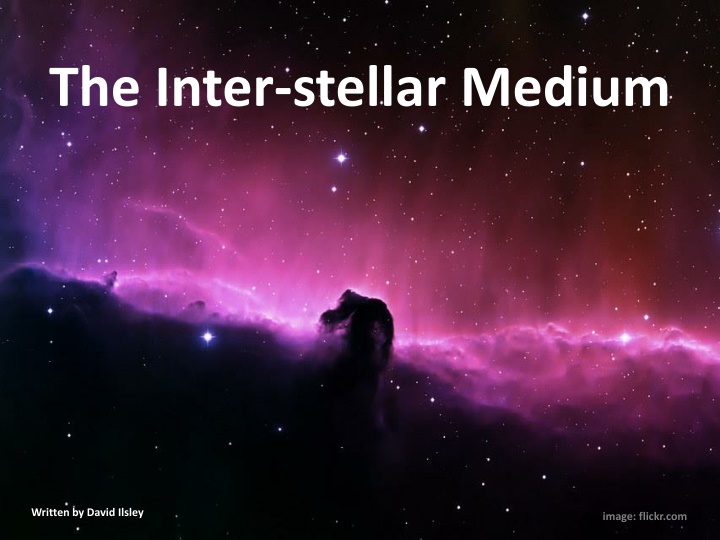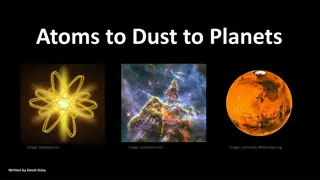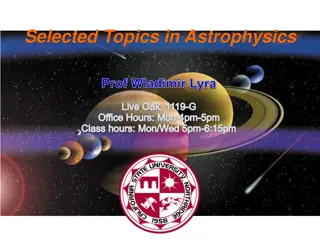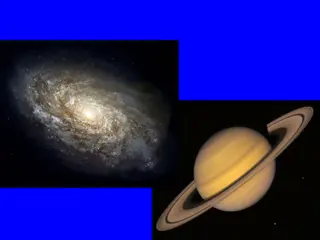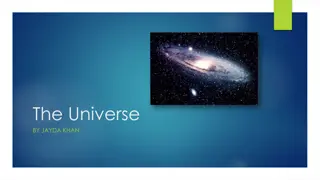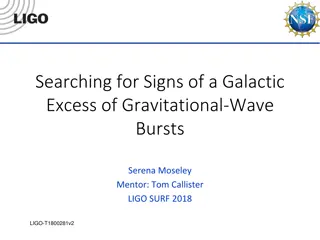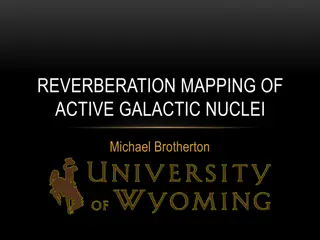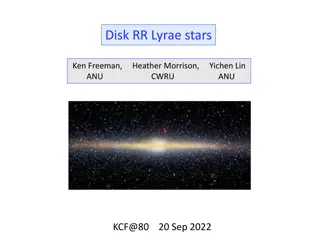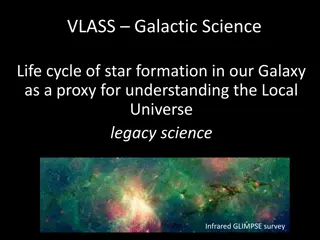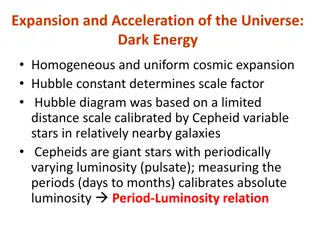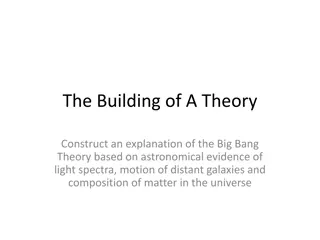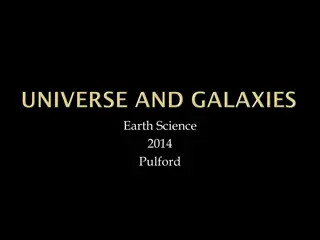Evolution of the Universe: From Big Bang to Galactic Recycling
380,000 years after the Big Bang, the Universe transitioned from a plasma to a gas, leading to the formation of atoms. Gravity caused gas clumps to form galaxies, stars, and other celestial bodies. The life cycles of stars play a crucial role in recycling material back into the inter-stellar medium, enriching it with various elements, transforming the composition of space over time.
Download Presentation

Please find below an Image/Link to download the presentation.
The content on the website is provided AS IS for your information and personal use only. It may not be sold, licensed, or shared on other websites without obtaining consent from the author.If you encounter any issues during the download, it is possible that the publisher has removed the file from their server.
You are allowed to download the files provided on this website for personal or commercial use, subject to the condition that they are used lawfully. All files are the property of their respective owners.
The content on the website is provided AS IS for your information and personal use only. It may not be sold, licensed, or shared on other websites without obtaining consent from the author.
E N D
Presentation Transcript
The Inter-stellar Medium Written by David Ilsley image: flickr.com
380 000 years after the Big Bang, the Universe became cool enough (about 3000K) for the electrons to combine with the protons and helium nuclei to form atoms. The Universe changed from a plasma to a gas. The gas was a mixture of hydrogen and helium, fairly evenly distributed through space. image: denstoredanske.lex.dk
As time went by, gravity caused some of the gas to condense into clumps on different scales. Large clumps formed into galaxies and clusters of galaxies. Many of the galaxies had black holes at their centres. image: flickr.com Smaller clumps formed into stars.
At first, the galaxies were mostly clouds of gas with just a few stars. But as time went on, more stars formed from the gas. In these early days many of the stars were quite massive. They lived fast and died young. image: publicdomainpictures.net
When they died, they threw around half their material back into the surrounding space, leaving behind smaller residual bodies (white dwarfs, neutron stars and black holes). image: pxfuel.com
The material that was thrown off was recycled back into the inter-stellar gas. The residual bodies accumulated and gradually removed free gas from the galaxy. image: pixabay.com
Smaller stars (those smaller than the Sun) burn slowly and stay as stars for many billions of years. image: commons.wikimedia.org Bodies smaller than stars brown dwarfs, planets etc. stay basically the same for ever. So these, too, remove free gas from the Milky Way.
In big stars, hydrogen burns to helium, then to carbon, oxygen and all the other elements up to iron. When the stars throw off their outer layers or explode, all these elements are thrown into the surrounding space. Supernovas produce elements beyond iron when they explode. Through this process, the gas between the stars gradually changed from being just hydrogen and helium to containing all the elements we see today. image: openclipart.org
As a result, our galaxy, the Milky Way, now contains about 200 billion stars and star remnants and many more smaller bodies like brown dwarfs, planets, asteroids, comets etc. These now contain about 95% of the light matter in the galaxy. The remaining 5% is the inter-stellar medium. The ISM consists not just of hydrogen and helium: about 2% of it is heavier elements. Astronomers call these metals.
The ISM consists of gas, plasma and dust. Elements like hydrogen, helium, nitrogen, neon etc. that don t react strongly with other elements remain as gas or plasma. Gas consists of single atoms or molecules; plasma consists of separate nuclei and electrons; Most of the other elements, like oxygen, magnesium, silicon, iron etc., react with each other to form microscopic solid particles dust.
The composition of the inter-stellar medium in the Milky Way is now something like this: image: commons.wikimedia.org
The ISM in the spiral disk of the Milky Way has different temperatures. This means that its particles move at different speeds. image: flickr.com
Most of the dust and about half the gas are cold (10-20 K). Because the particles move slowly, this gas and dust tends to stay within a few hundred light years of the plane of the Milky Way s disk. image: commons.wikimedia.org The density of the gas and dust varies from very thin to quite dense. Where they are dense, they form clouds with hundreds to millions of atoms per cubic centimetre.
Being cold, the hydrogen gas in these clouds forms molecules. The clouds are called Molecular Clouds. Molecular clouds with their associated dust particles form most of the nebulae we see from Earth. image: pxhere.com
Some of the molecular cloud nebulae in our galaxy. image: flickr.com image: flickr.com image: commons.wikimedia.org image: flickr.com
Other nebulae are formed by the material thrown off red giants and supernovae. These are called planetary nebulae and supernova remnants respectively. image: commons.wikimedia.org
Some of the planetary nebulae and supernova remnants in the Milky Way image: flickr.com image: flickr.com image: commons.wikimedia.org image: pxfuel.com image: pxfuel.com image: pixabay.com
In addition to the molecular clouds, there is also hot (fast moving) material produced by stellar explosions. Initially its temperature is a few million degrees. Some of this material escapes the gravity of the galaxy, but some of it is drawn back to the plane of the galactic disk and forms a layer about 10 000 light years thick. It has a very low density (0.01 to 0.0001 atoms per cubic centimetre) and, being hot, it is ionised. It is called Hot Ionised Medium.
Each time the particles of the hot ionised medium pass through the plane of the Milky Way, many of them collide with slower particles and so slow down, eventually becoming Warm to Cold Medium with temperatures around 50 - 10 000 K and a density of about 0.2 to 50 atoms/cm3 or becoming part of the molecular clouds. The warmer medium tends to be ionised; the colder medium tends to be neutral.
Finally, there are HII Regions (pronounced H2). These are regions of the molecular clouds which have been warmed up and ionized by the radiation from nearby stars. image: flickr.com
Fractional Volume, Mass Scale Height (ly) Temperature (K) Density (atoms/cm ) State of hydrogen Component ionized (metals also highly ionized) 50% <1% 106-107 10 4-10 2 Hot Ionized Medium 1000-3000 neutral atomic or ionized Cold to Warm Medium 50% 45% 100-1000 50-10 000 0.2-50 < 1% 50% 102-106 Molecular Clouds 80 10-20 molecular < 1% 5% 102-104 HII Regions 70 8000 ionized
The molecular clouds form the nebulae in which new stars are born. These clouds tend to form and dissipate in space. They form when the ISM is compressed, either by the passing of a spiral arm of the galaxy or by a shock wave from a supernova explosion. image: flickr.com
When they are compressed, small regions within the molecular clouds become dense enough for their gravity to pull them together to form a star. In this process, they start as opaque clouds, then condense down further to one or more Bok Globules. image: flickr.com
Each Bok globule then condenses down to a star, usually with a disk of matter orbiting it. This disk later forms planets. image: commons.wikimedia.org
Numerous stars tend to form from a molecular cloud. image: pixabay.com
The stars have a range of sizes from blue giants, many times the mass of the Sun, down to red dwarfs and brown dwarfs. Though only a small minority are blue giants, these shine very brightly and so tend to make up most of the stars that we can see through a telescope. image: en.wikipedia.org
The blue giants have a very strong solar wind and this blows away the remaining gas and dust of the molecular cloud within the vicinity of the developing stars. The group of stars then becomes an open cluster. image: pixabay.com
Later the stars separate as they move around the galaxy. The Sun would have started this way as part of a cluster, but the other stars in the cluster have long since moved far away and got lost amongst the other stars of the galaxy. image: pixabay.com
So far we have talked about the Milky Way and, in particular, the spiral disk where we live. The central bulge and the halo of the Milky Way contain far less inter-stellar medium than does the disk. image: piqsels.com
Consequently, few stars are formed in these areas and so there are few bright blue stars. Blue stars last only a few million years and, as they are not being replenished by molecular clouds, the blue stars have mostly died out long ago, leaving red and yellow ones. image: publicdomainpictures.net
Most spiral galaxies are similar the thick ISM and bright young blue stars are in the spiral arms; the central bulge and halo are mostly old yellow to red stars with little ISM. image: flickr.com
Elliptical galaxies are like the central bulge of the Milky Way in that they have very little IMS and thus very few young blue stars. They consist mostly of old yellow to red dwarf stars and presumably brown dwarfs. image: en.wikipedia.org
The Inter-galactic Medium image: commons.wikimedia.org
So that describes the inter-stellar medium within galaxies. There is also matter between the galaxies an inter-galactic medium. image: commons.wikimedia.org
In fact there is about 10 times as much light matter between the galaxies as there is in them. About 4% of the universe is light matter and only about 0.4% is in galaxies. image: commons.wikimedia.org
The inter-galactic medium consists mostly of hydrogen and helium which has not been incorporated into galaxies. So it is fairly much the way it was when the universe was young. Some powerful supernovas do eject material into inter-galactic space, so the IGM does contain some metals, but far less then the ISM in our galaxy.
The IGM is, in places, being sucked into the galaxies by their gravity, replenishing their ISM. It would take hundreds of billions of years, however, for most of it to be sucked in. By that time the Universe will have expanded so much that the galaxies will be few and far between. So most of the IGM will always remain IGM.
The density of the IGM is thought to average about 1 atom per cubic metre. There are, however, denser clouds called Alpha- Lyman Blobs, and less dense areas. image: commons.wikimedia.org
